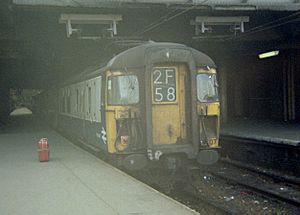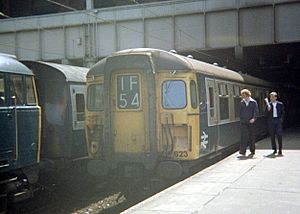British Rail Class 309 facts for kids
Quick facts for kids British Rail Class 309 |
|
|---|---|

Two Class 309 electric multiple units coupled together at London Liverpool Street. One of these is in Network SouthEast livery and the other is in "Jaffa Cake" livery with "Essex Express" branding.
|
|
| In service | 1962-2000 |
| Manufacturer | BR York |
| Number built | 1962-1963 |
| Formation | 2/3/4 cars per trainset |
| Operator(s) | British Rail |
| Specifications | |
| Maximum speed | 100 mph (160 km/h) |
| Weight | Total - 99 tons (309/1) Only
Total - 168 tons (309/2) Only Total - 167 tons (309/3) Only |
| Braking system(s) | Air (EP/Auto) |
| Track gauge | Standard gauge (1,435 mm) |
The British Rail Class 309 electric trains were special passenger trains built in the early 1960s. They were known as the "Clacton Express" because they often ran fast services to places like Clacton-on-Sea. These trains were built by British Rail (BR) at their York factory between 1962 and 1963.
When they were first made, these trains had a different name: Class AM9. This changed later when British Rail introduced a new system called TOPS. The Class 309 trains were very important because they were the first express electric trains built by British Rail that could use 25,000 volts of alternating current (AC) electricity. They were also the first electric trains from British Rail that could travel as fast as 100 miles per hour (160 km/h).
Contents
What Made the Class 309 Special?
The Class 309 trains were designed for speed and comfort. They were meant to carry many passengers quickly between London and the East Coast of England.
High Speed and Power
These trains were pioneers in fast electric travel.
- They could reach speeds of 100 mph (160 km/h). This was very fast for trains at that time.
- They used a powerful 25,000-volt AC electricity system. This allowed them to run smoothly and quickly.
- The trains were built to handle long journeys. They offered a good experience for passengers.
Design and Appearance
The Class 309 trains had a distinctive look.
- They were often seen in the classic blue and grey colours of British Rail.
- Some trains later got new paint jobs. These included the bright "Jaffa Cake" livery. This design had orange and grey colours.
- The front windows of the driver's cab were unique. Some trains had large, curved "wrap-around" windows. Others were later updated with flatter, modified windows.
How Many Carriages?
The Class 309 trains could be made up of different numbers of carriages.
- Some trains had two carriages.
- Others had three or four carriages.
- This flexibility allowed them to carry different numbers of passengers. It depended on how busy the route was.
Where Did the Class 309 Trains Run?
The Class 309 trains mainly operated on routes from London.
The "Clacton Express" Route
Their most famous route was the "Clacton Express".
- These trains ran from London Liverpool Street.
- They travelled to towns on the Essex coast.
- Popular destinations included Clacton-on-Sea and Walton-on-the-Naze.
- They provided a fast link for commuters and holidaymakers.
Later Years and Retirement
The Class 309 trains served for many years.
- They were in service from 1962 until 2000.
- Some trains were updated between 1985 and 1987. This helped them stay modern.
- After nearly 40 years, they were eventually replaced by newer trains.
- Even though they are no longer in service, the Class 309 trains are remembered. They played an important part in the history of British railways.



